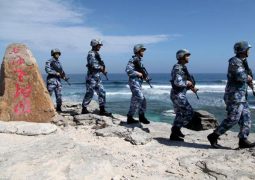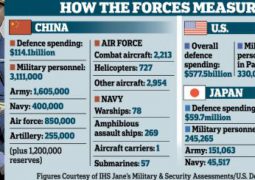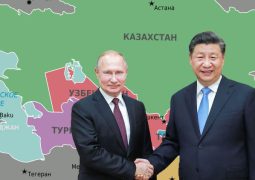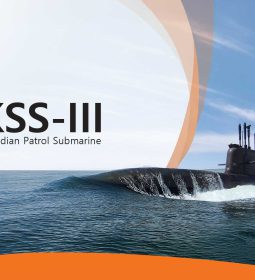Policy Analysis: What the Berlin Airlift Can Teach Us About the South China Sea

By Ngo Di Lan
The U.S. failure to counter China’s “gray zone” tactics stems from a lack of will, not a lack of options.
Although the Trump administration is taking an increasingly harder line vis-à-vis Beijing, there is little doubt that the United States has failed to counter Chinese expansion via salami-slicing in the South China Sea (SCS). Current debates imply that this failure is rooted in a lack of imagination or capabilities, as experts continue to propose approaches that the United States can adopt to fight against gray zone tactics, such as those employed by Russia in Ukraine or by China in the SCS. However, we already have an example from history of a successful U.S. response to gray zone pressure: the Berlin Airlift. This strongly suggests that the United States can respond effectively to gray zone tactics when core American interests are at stake. Thus the key issue in the SCS is a lack of U.S. willingness to confront China, not a matter of tactics or strategy.
Into the Gray Zone: New Concept, Old Tactics
Only in recent years have scholars begun talking about “gray zone tactics,” which often consist of coercive actions that are deliberately calibrated to fall below the threshold of open armed conflict. These ambiguous and incremental challenges degrade the target’s ability to respond and minimize the risks of war at the same time. By employing these tactics, the challenger advances its interests while convincing the target that it would be better off making small concessions rather than responding decisively and running the risk of escalation. As such, if successful, gray zone tactics will allow the challenger to “win without fighting” because they circumvent the tripwire that could lead to a strong response from the target.

In 2014, for example, Russia successfully used their “little green men” in tandem with information warfare to create a territorial fait accompli in Crimea. For the past five years, China has steadily consolidated and expanded their presence in the South China Sea through land reclamation efforts and a massive fleet of maritime militia disguised as fishing boats.
While these challenges may seem new, countries have been employing gray zone tactics as early as the Cold War or even earlier. Stalin’s decision to cut off Allied access to Berlin or Nasser’s nationalization of the Suez Canal could both be characterized as gray zone tactics. The only thing that is new about today’s gray zone challenges are the means employed. A hyperconnected world and highly precise weapons have allowed aggressive actors to carry out evermore sophisticated gray zone attacks. Yet the nature of the challenge remains the same and the solution deceptively simple.
Looking Back at the Berlin Airlift
In many ways, the Cold War revolved around the German question and Berlin itself. The first true crisis between the two blocs happened in Berlin, following American and British efforts to introduce the new Deustchmark into Bizonia and West Berlin. In response, the Soviets blocked all major road, rail, and canal links to West Berlin, thus starving the city of all essential supplies. Stalin calculated that his blockade would put sufficient pressure on the West to force concessions in Berlin while avoiding war as he knew that the United States and its allies were not willing to fight through the blockade and risk another major war in Europe.
Western leaders thus faced a conundrum: capitulation would likely lead to Soviet domination of Germany, yet a hardline response to break through the blockade would be too risky, especially given Soviet military superiority in conventional terms. Furthermore, if war broke out as a direct result of Western actions, that could lead to a major propaganda victory for Moscow. Therefore, they had to find a way to circumvent the blockade without waging a war.
In the end, the United States and its allies decided to launch a massive airlift operation, supplying the western sector of Berlin by air rather than land or sea. In doing so, the West undermined the Soviet blockade and put the onus of igniting a shooting war on the Kremlin. American and British policymakers fully understood that although Soviet leaders wanted influence over Berlin, they equally dreaded the prospect of a major armed conflict. The gamble eventually paid off as Stalin called off the blockade in the spring of 1949, giving the West a major victory over the hearts and minds of many Berliners.
From Berlin to the South China Sea: The Big Lesson
While the parallel between the Soviet blockade in Berlin and China’s actions in the SCS is imperfect, the two cases are similar in one crucial aspect: In both cases, the United States faced a situation where it had to choose between making a concession or risking war vis-à-vis a great power adversary. This is a lose-lose situation for Washington because neither option is appealing. However, because U.S. homeland security has never been predicated on American control over Berlin or the SCS, concession is always the more attractive option.
However, the Berlin Airlift shows that the United States will find a way to fight back a gray zone challenge if leaders in Washington perceive that core U.S. interests are at stake. In the eyes of Americans, Berlin was not a mere city — it was the symbol of the Cold War struggle between two superpowers, with their two opposing ideologies and ways of life. Losing Berlin could mean losing Germany and even the Cold War itself, which was certainly an unacceptable outcome. In that situation, the United States committed itself to a game of chicken against the Soviets, knowing that if Soviet leaders shot down a single plane, the West would have no choice but to go to war.

This strongly suggests that the United States has failed to counter China in the SCS mostly because it lacks the willingness to directly challenge Chinese control over this region. Had U.S. leaders felt that the SCS were more important to U.S. security, they would be more willing to run the risk of a hot war against China over the SCS. For instance, Washington could announce that the U.S. Navy would protect all vessels transiting through this region, regardless of Chinese protests or even attempts to close off the SCS. And yet they have not and will probably not make this announcement anytime soon because doing so would provoke Beijing in unpredictable ways.
Freedom of navigation in the SCS might be important to the United States but it is certainly not important enough for American leaders to risk their own security. That — and not a lack of creative ideas or capabilities — is the real reason why the U.S. has failed to counter Chinese gray zone tactics in the SCS.
Ngo Di Lan is a Ph.D. candidate in International Relations at Brandeis University.
- Previous With Savings to Burn, Russia Turns (Again) to a State-Led Spending Plan _NY Times
- Next Policy Analysis: The Key to Post-World War II US Strategic Thinking About Japan
















